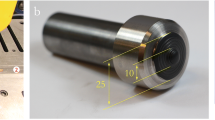Abstract
The objective of this study was to investigate the influence of softening in the heat-affected zone of welds and the constraint effect on the transverse tensile strength of a microalloyed, thermomechanically controlled processed (TMCP) high-strength steel grade. The welding was performed with three different levels of energy input to establish soft zones with varied extensions to investigate the dimension of softening and to determine the constraint effect on various widths of the soft zone. The results showed that the tensile strength was not significantly compromised by softening in the HAZ. The reason for this is the constraint effect of the base metal and the high strength of the weld metal. In conclusion low heat input welding processes keep the soft zone small and the strength high.
Similar content being viewed by others
References
Klein M., Spindler H., Luger A., Rauch R., Stiaszny P. and Eigelsberger M.: Thermomechanically hot rolled high and ultra high strength steel grades — Processing, properties and application, Materials Science Forum, 2005, pp. 500–501, pp. 543-550.
de Meester B.: The weldability of modern structural TMCP steels, ISIJ International, 1997, vol. 37, no. 6, pp. 537–551.
Youn J.G. and KimH.J.: Characteristics of TMCP steel and its softening, Proc. Int. Sym. on Welding Metallurgy of Structural Steels, 1987, pp. 157-168.
Honeycomb R. and Bhadeshia H.K.D.H.: Steels — Microstructure and properties, 2nd edition, 1995, Edward Arnold.
Wallner F.: Grundsätzliches zur Schweißeignung wasservergüteter hochfester Al-Si-Mn-Feinkornbaustähle, Basic information on weldability of high-strength quenched and tempered Si-Mn-Al fine grained steels Dissertation, 1972, Technische Universität Graz (in German).
Panda S.K., Sreenivasan N., Kuntz M.L. and Zhou Y.: Numerical simulations and experimental results of tensile test behavior of laser butt welded DP980 steels, Journal of Engineering Materials and Technology, 2008, vol. 130, no. pp. 041003–1–041003–9.
Mennen J.: Schweißen von Vergütungsstählen, Welding of heat treatable steels, DVS-Berichte 23, 1962, pp. 18–25 (in German).
Müller R.: Probleme beim Schweißen von vergüteten Baustählen, Problems arising out of the welding of heat treatable construction steels, DVS-Berichte 46, 1966, pp. 54–61 (in German).
Unfried J.S., Garzon C.M. and Giraldo J.E.: Numerical and experimental analysis of microstructure evolution during arc welding in armor plate steels, Journal of Materials Processing Technology, 2009, vol. 209, no. 4, pp. 1688–1700.
Denys R.: The effect of HAZ softening on the fracture characteristics of modern steel weldments and the practical integrity of marine structures made by TMCP steels, Proceedings of the International Conference on Evaluation of Materials Performance in Severe Environments — EVALMAT, 1989, vol. 2, pp. 1013-1027.
Wallner F., Schimböck R. and Rauch R.: Verbesserte und neue TM-Stähle für geschweißte Konstruktionen, Advanced and new TMCP-steels for welded constructions, Internationale Schweiß- und Fertigungstechnische Tagung, 2000, Wien (in German).
Shron R.Z. and Bakshi G.A.: The problem of gauging the strengths of welded joints in which there is a soft interlayer, Welding Production, 1962, no. 9, pp. 11-14.
Satoh K. and Toyoda M.: Static tensile properties of welded joints including soft interlayer, Transactions of the Japan Welding Society, 1970, vol. 1, no. 1, pp. 7–12.
Satoh K. and Toyoda M.: Static strength of welded plates including soft interlayer under tension across a weld line, Transactions of the Japan Welding Society, 1970, vol. 1, no. 2, pp. 10–17.
Ostsemin A.A.: Stress state and static strength of mechanically inhomogeneous welded joints, Report 1 — Evaluating the effect of significant amounts of inhomogeneity on the static strength of welded joints, Strength of Materials, 1991, vol. 23, no. 4, pp. 398–405.
Rodrigues D.M., Menezes L.F., Loureiro A. and Fernandes J.V.: Numerical study of the plastic behaviour in tension of welds in high strength steels, International Journal of Plasticity, 2004, no. 20, pp. 1-18.
Mochizuki M., Shintomi T., Hashimoto Y. and Toyoda M.: Analytical study on deformation and strength in HAZ-softened welded joints of fine-grained steels, Doc. IIW-1573, Welding in the World, 2004, vol. 48, no. 9-10, pp. 2–12.
Satoh K. and Nagai A.: Fatigue strength of welded bars having a hard or soft interlayer, IIW Doc. XIII-530-69, 1969.
Pisarski H.G. and Dolby R.E.: The significance of softened HAZs in high strength steels, Doc. IIW-1575, Welding in the World, 2003, vol. 47, no. 5-6, pp. 32–40.
Angeli J., Füreder E., Panholzer M. and Kneissl A.C.: Ätztechniken für die Phasencharakterisierung von niedriglegierten Dual-Phasen- und TRIP-Stählen, Etching techniques for characterizing the phases of low-alloy dual-phase and TRIP steels, Praktische Metallographie, 2006, vol. 43, no. 10, pp. 489–504 (in German).
EN 10149-2: 1995, Hot rolled flat products made of high yield strength steels for cold forming — Part 2: Delivery conditions forthermomechanically rolled steels.
EN ISO 16834: 2007, Welding consumables — Wire electrodes, wires, rods and deposits for gas-shielded arc welding of high strength steels — Classification.
Delivery conditions for filler metal Union X85, Böhler Schweißtechnik GmbH.
EN 439: 1995, Welding consumables — Shielding gases for arc welding and cutting.
ISO 6507-1: 2005, Metallic materials — Vickers hardness test — Part 1: Test method.
EN 10002-1: 2001, Metallic materials — Tensile testing — Part 1: Method of test at ambient temperature.
Lundin C.D. and Mao T.P.S.: Heat affected zones in low carbon microalloyed steels, Proc. Recent Trends in Welding Science and Technology, 1989, pp. 249-256.
EN 1993-1-9: 2005, Eurocode 3: Design of steel structures — Part 1-9: Fatigue.
Author information
Authors and Affiliations
Rights and permissions
About this article
Cite this article
Hochhauser, F., Ernst, W., Rauch, R. et al. Influence of the Soft Zone on The Strength of Welded Modern Hsla Steels. Weld World 56, 77–85 (2012). https://doi.org/10.1007/BF03321352
Published:
Issue Date:
DOI: https://doi.org/10.1007/BF03321352




